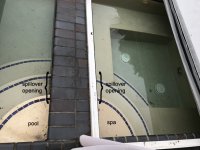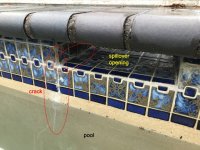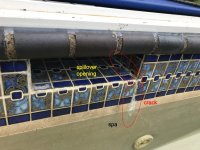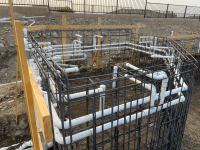I found a calcified crack on the dam between pool and adjacent spa, which is situated in the corner of the spillover opening and extends a few inches down on pool and spa gunite walls on each side, as shown on attached pics. I suspected loss of water last season and after winter I found that in covered pool and spa water indeed dropped an inch or so below skimmer openings, but not much lower. I thought that the above crack in the dam wall may be the reason for water loss, because in Oregon two last winters we had a few days when temp dropped below freezing. However, when I showed these pics to pros, some said that a crack in the dam wall is unlikely the reason because water has nowhere to go there due to the way such wall is normally constructed. Most likely leaks are in skimmers, skimmer plumbing or the floor sweep line, which are closer to the surface. I had all those lines blown out and plugged for winter, so water should not be lost through empty plumbing. Also, the crack is clearly calcified, which likely comes from ground water. During abundant winter rains in Oregon, the water table is pretty high and ground water may be seeping into the pool trough this crack forming the observed deposit. Indeed, after recent rain the water level in the pool seem raised an inch or so as compared to what I observed when pool was opened a few days before the last rain after a week of dry weather. I would appreciate comments on that from members with the needed expertise.
leak trough crack in pool dam wall and spillover opening?
- Thread starter yaximik
- Start date
-
- Tags
- calcification crack leak pool dam





